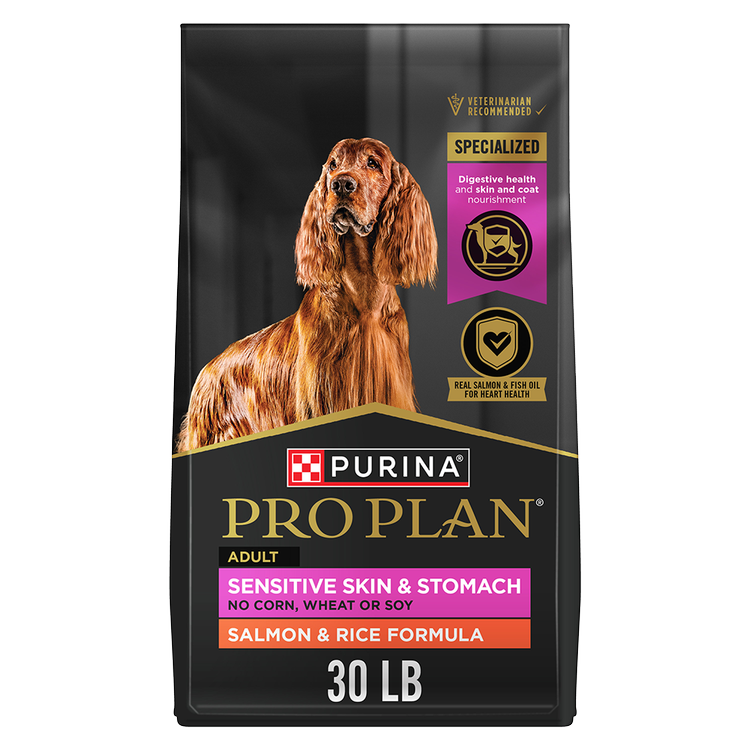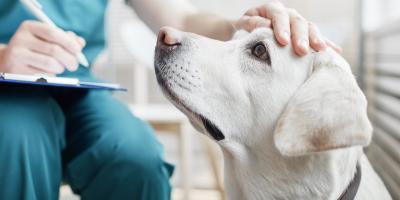Why Is My Dog Losing Hair in Patches?


Dogs lose hair for several reasons. In some cases, it can be addressed with home remedies. In others, they may need veterinarian-prescribed medications.
Either way, your dog's coat is more than just a breed trait or something that makes them warm and cuddly. Your dog’s skin is the largest organ in their body and their barrier to the outside world. Their skin is critical to their overall health and their coat is a significant part of that. As such, you can look to your dog’s coat as a good indicator of their overall health.
Canine Hair Loss Causes & Treatments
Here are some of the more common causes of canine hair loss and possible treatments. Your first step in addressing your dog’s hair loss is to get in touch with your veterinarian. They can help diagnose the cause and provide a treatment plan moving forward.
Poor Nutrition
One potential cause of hair loss in dogs is lack of proper nutrients in their diet. Ensuring your dog gets the appropriate nutrition to help their skin and coat health thrive can often be as simple as choosing a sensitive skin and stomach dog food.
These formulas are designed to promote digestive health, meaning your dog can absorb the nutrients from the diet and use them for important processes, like developing a healthy coat. Since skin and hair are made of protein, having high-quality protein in the diet is essential.
Sensitive skin and stomach dog foods are also rich in omega-6 fatty acids which are excellent for boosting dogs' skin and coat health and appearance.
Sensitive skin and stomach dog foods aren’t always necessary, though. Talk to your veterinarian about what dog foods your dog needs and how much they need if you’re worried their hair loss may be linked to improper nutrition.
Parasite Infestation
Fleas: Few things irritate dogs and dog owners as much as fleas. Not only do they multiply quickly, but they can spread from dogs to people and leave itchy, irritating bites throughout the body. Fleas, which are about the size of a poppy seed, are hard to see and spend their time “hiding” in dark places. Once they become visible on a dog’s fur, it usually indicates that there’s an infestation. Another sign of fleas is the “flea dirt” they leave behind, which is the droppings they leave on your dog's coat.
A common symptom of flea infestation, aside from bumps, sores and scabbing, can also be hair loss, so if your dog is losing hair in patches, it may be a good idea to check for fleas by running a comb through their hair or taking them to the veterinarian for an exam.
Oral or topical medication prescribed by your veterinarian is an effective way to knock out fleas. While home remedies and over-the-counter products are widely available, it should be noted that many of them lack effectiveness. A thorough cleaning of your dog's environment will be crucial to ensure residual fleas and flea eggs don’t cause a reinfestation.
Sarcoptic Mange/Scabies: Another pesky and often painful condition for dogs is sarcoptic mange, also called scabies, caused by the scabies mite. The scabies mite makes itself at home by burrowing into the skin and laying eggs under the skin’s surface can, and causing itchy hives, sores, bumps and crusty patches. Hair loss from this condition is caused by dogs biting and scratching at the source of irritation.
Even in extreme cases, scabies can be effectively treated by your veterinarian through injections, medications and baths. Since scabies are highly contagious (even to people), it’s essential to do a deep clean of your dog’s environment, bedding and anything he regularly comes in contact with to eliminate the possibility of reinfection or infecting other animals or people in the household.
Demodectic Mange/Demodex: A common part of the flora of canine skin is a tiny, cigar-shaped mite known as Demodex Canis. These mites spend their lives inside your dog’s hair follicles, are usually harmless and typically go unnoticed by dogs and dog owners alike. In cases where puppies and dogs have immune deficiency, however, their immune systems become inefficient in keeping the population of these mites in check.
Demodectic mange symptoms can present as scaly skin, redness, swelling and—in extreme cases—significant hair loss. Fortunately, demodectic mange is not contagious to humans or other animals within the household, but nonetheless should be treated quickly.
Your veterinarian will likely recommend a combination of medicated shampoos, topical compounds, and oral treatments to help your dog recover from this demodectic mange.
Fungal & Bacterial Infections
Ringworm: A fungal infection (not an actual worm), ringworm affects the thermos layer of skin, hair follicles and sometimes the nails and is spread by making direct contact with the fungus. Ringworm is often easy to spot, as it causes round, raised, hairless patches. The affected area can often be itchy, causing your dog to scratch, leading to scabbing in the area.
Treating ringworm quickly is crucial because it can be quite irritating for your dog and contagious to other dogs and human family members. Depending on how severe the infection is, your veterinarian may use topical creams or shampoos and oral prescription antifungal medications.
Allergic Reaction
Atopic Dermatitis: An allergic reaction that affects roughly 3 in 10 dogs, atopic dermatitis can be caused by a dog’s immune response to allergens. Typically, innocuous environmental factors like mold, pollen, dust and mites cause allergic reactions in some dogs and can cause excessive itching and scratching, potentially leading to bumps, rashes, scabbing and hair loss.
Treatment for atopic dermatitis can include immunotherapy, steroids, oral medications and injections to help your dog battle their allergies.
Medical Conditions
Canine Pattern Alopecia
Like humans, dogs can get alopecia, which for dogs is the loss of hair or patches of baldness in areas of your dog's coat. This hair loss results from the miniaturization of hair follicles in a particular area of your dog’s skin.
While studies on canine pattern alopecia leave much to be desired in terms of the causes, there seems to be some evidence to suggest this condition may have a genetic component and may be more prominent in certain dog breeds. In some cases, alopecia can be caused by topical steroid usage.
The good news about canine pattern alopecia is it’s benign and won’t cause harm to your dog. Options like topical minoxidil or melatonin therapy may be helpful. Reach out to your veterinarian to find out more.
Thyroid Disease
Both hypothyroidism and hyperthyroidism are diseases that are caused by the thyroid gland not secreting enough thyroid hormones, or secreting too many thyroid hormones, respectively. Each of these conditions can result in hair thinning or hair loss. Symptoms to look for include:
Hypothyroidism Symptoms:
- Lack of interest in exercise
- Lethargy
- Weight gain
- Obesity
- Thinning or loss of fur
- Poor skin health/appearance
Hyperthyroidism Symptoms:
- Increased excitability
- Unexpected weight loss
- Increased thirst
- High appetite
- Frequent urination
- Enlarged thyroid gland
- Congestive heart failure
- Increased heart rate
- Shortness of breath
Cushing's Disease
Cushing’s Disease (hyperadrenocorticism) in dogs is a serious condition that occurs when the pituitary gland or one of the adrenal glands signals for the cortex to release unusually elevated levels of the “stress hormone” known as cortisol. It’s often caused by a tumor on the pituitary gland.
Symptoms include:
- Hair loss
- Decreased skin health
- Recurring skin infections
- Increased thirst and urination
- Reduced activity
- Excessive panting
- Enlarged abdomen
If you feel that your dog is exhibiting symptoms that are consistent with any of the above health conditions, schedule an exam with your veterinarian as soon as possible.
Reaction to Medical Treatment
Sometimes dogs may temporarily lose hair following medical treatments like injections and the application of topical medications. Generally, as in the case of post-injection panniculitis or rabies vaccination panniculitis, treatments are effective in restoring hair growth in the affected area.
Hair loss in dogs, like any health issue, should be treated sooner rather than later. With a trip to the veterinarian, you’ll learn the cause and course of treatment so your dog’s skin and coat can be on the road back to health.
Get more valuable insights about your dog by finding out what our experts have to say on our Pet Expertise page.
Related articles

Reward Yourself with myPurina
Earn and redeem rewards for Purina products with the myPurina app.






